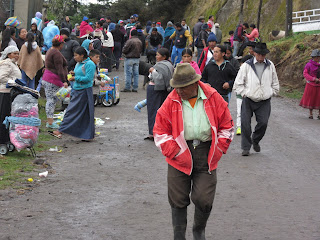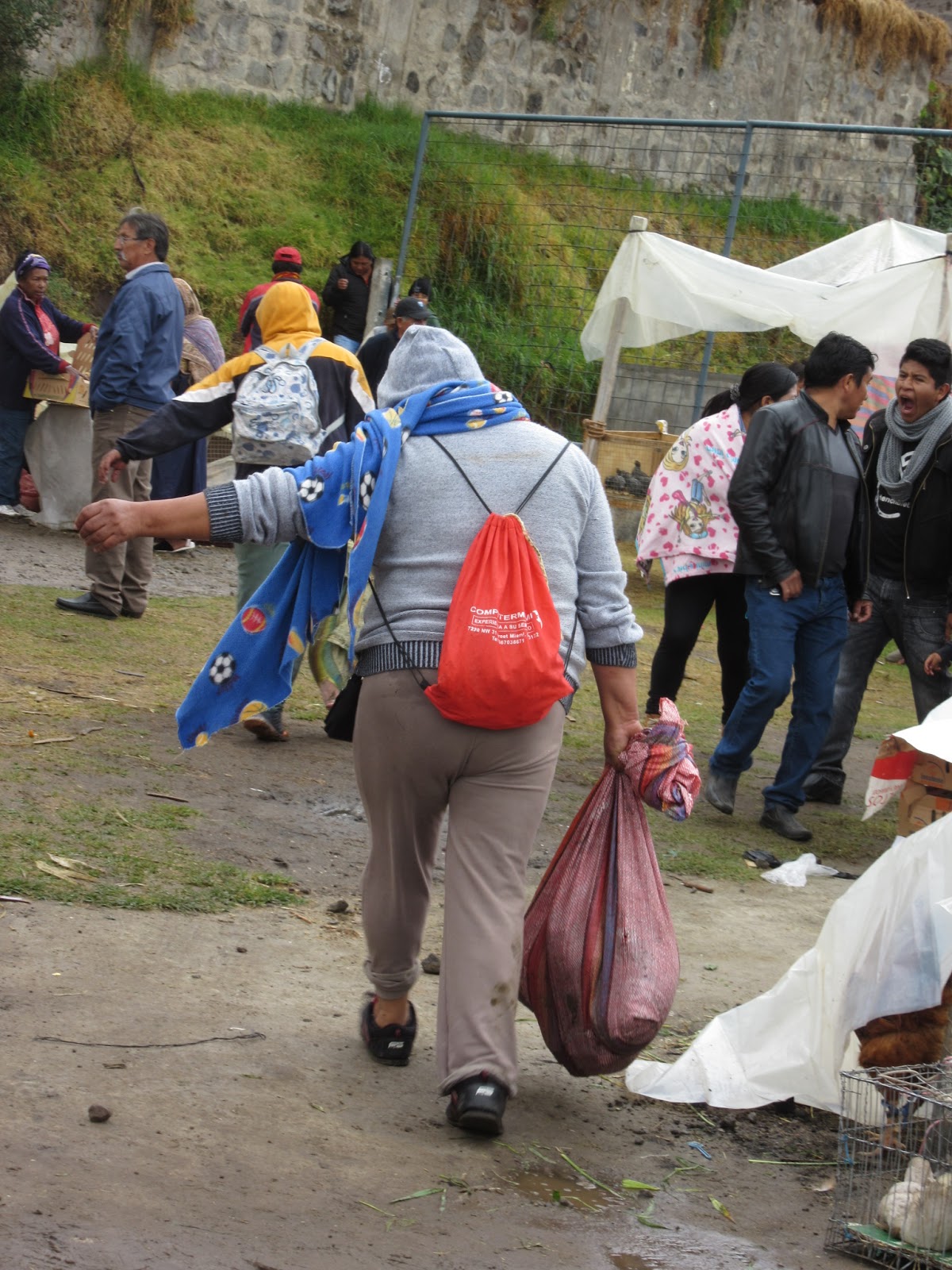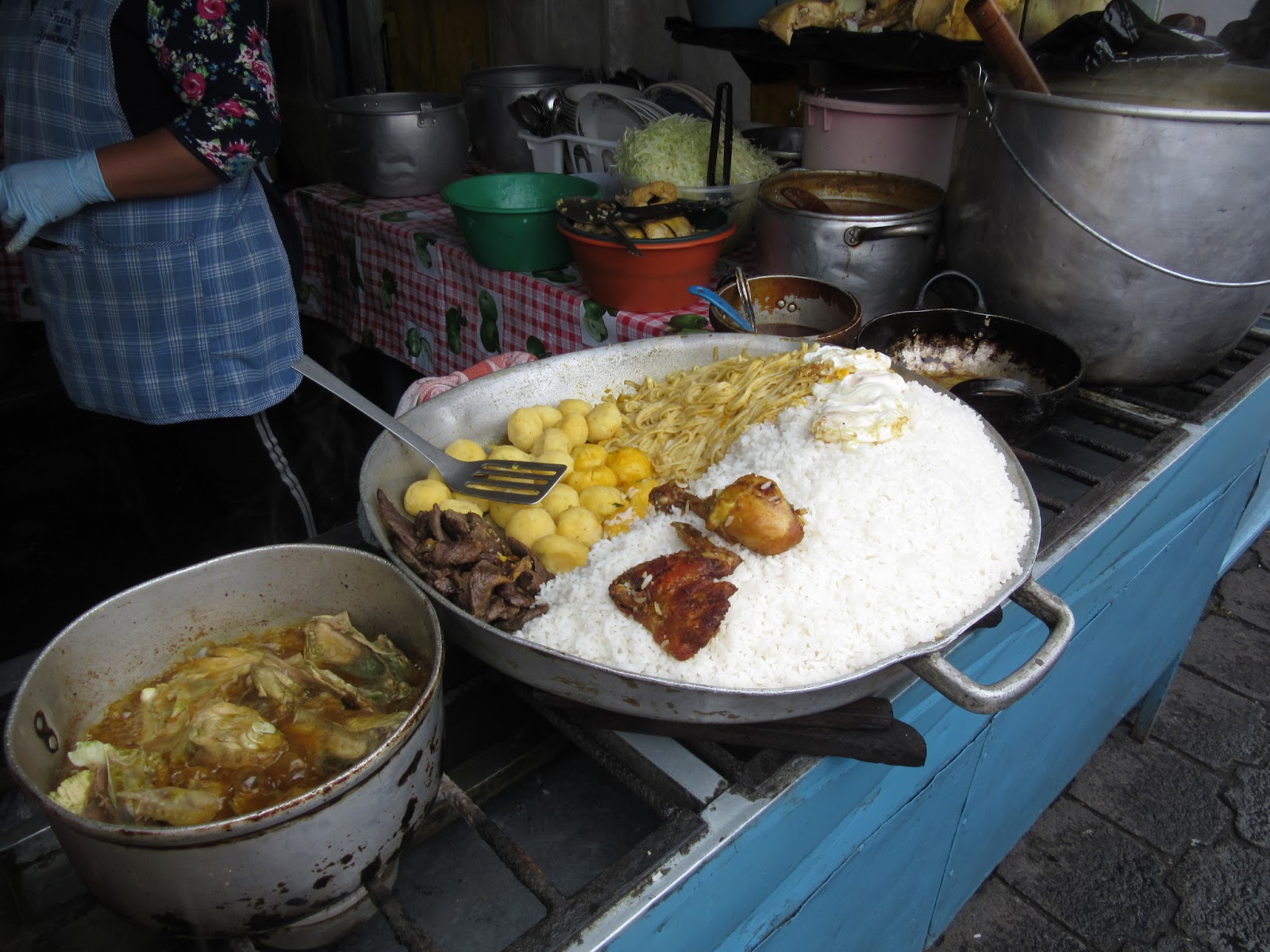Note: As with any post, if you want to enlarge any photo, just click on it.
We had come to Otavalo, Ecuador primarily for the Saturday artisans market but our first stop in the morning was not the artesania market but the weekly Mercado de Animales on the other side of the Panamerican Highway as it ended at 10. It was where local farmers bought and sold their livestock.
It was hard not to be struck by how much shorter the people in Otavalo were compared to those in Quito. Both Steven and I felt tall!
Walking through the market was like a wannabe photographer's dream seeing the people in local attire.
This woman's bag must have weighed as much as she did.
Because of the intermittent rain, many hats were covered with plastic.
Steven and I get many a stare and often a smile when wearing our matching 'apple' ponchos we bought a couple of years ago in Vietnam.
Some of the pretty embroidered camisetas or blouses the women and many girls wore.
We saw massive displays of what looked like huge green onions to me.
After visiting the open animal market, we made our way to the permanent animal market which sold mostly fowl, cuyes aka guinea pigs and also fruits and vegetables.
More great people-watching opportunities:
More of the fascinating street light designs that I was so intrigued by in my previous post:
Thanks to the great graffiti tour guide in Bogota, we had a new found appreciation of Otavalo's street art.
Someone accurately referred to the market as a ‘Flea Market on Steroids.’ The town square filled with vendors of indigenous peoples’ crafts and art - who could ask for more?!
The indigenous women dressed in all their finery offered a splendid choice of clothes, textiles, hammocks and weavings as well as jewelry, ceramics, dolls and many other craft items.
I watched entranced as a woman wielded her long knife and kept whacking away at the mango or was it a papaya? I kept getting those two confused!
The jewelry section of the market attracted my attention as I wanted to buy at least one pair of silver earrings to replace those taken from me when I had been mugged in Quito.
I mentioned in the previous post about the 20-30 strands of gold-colored beaded necklaces worn by the local women. Here they were for sale.
Lots of vendors sold what they said were coral necklaces. Coral or not, they were pretty.
We bought a small painting from this artist. It will be interesting where we find wall space once we get it framed.
Also plentiful were heaps of rolls of every sort being sold. They looked far more enticing than they turned out to be as we bought some, only to find they must have been baked at least the previous day.
Suellen, Kay and Janina: I thought of the three of you when I saw these unruly skeins of yarn!
Gloria: I bought something for you from this woman who, unasked, then showed me her lovely blouse. I imagine she embroidered it herself as she was selling beautifully handmade items.
There were plenty of vendors who advertised ‘alpaca scarves and sweaters,’ some for impossibly cheap prices that they couldn’t possibly be real alpaca so I didn’t buy those. Plus, the woolen items were heavy and we didn’t want that extra weight at that stage of our trip.
Since many stalls had similar items, we wandered around as we had no place to go or to be by a certain time. We knew we could always go back to one if we later discovered one vendor had the best price or color. Of course, that depended on if we could find the particular stall again!
Because Steven and I have a small collection of painted gourds, most from Berea, Kentucky, these ones caught my eye. It took a while trying to decide which one to buy as each design told its own story.
The hand-knit items were so attractive but again too bulky for us.
Fried bananas, anyone?
Darlene: I wish you could have been there with us as I can't imagine your not having the time of your life seeing them too.
Jose had a huge assortment of stunning weavings for sale in the shop but said he had also several other shops tucked away in the village that he could take us to on the chance we might find something we liked there.
The weavings were absolutely spectacular and the prices extremely reasonable but again our priority was getting something of a practical size that we could comfortably lug around for a good chunk of the trip still before mailing it and other purchases home.
How adorable were these llamas, our first of many sightings, I'm sure.
We decided to hike up the steps for a better view of the falls.
'The world is yours.'
Even though we had limited knowledge of Spanish, we could understand the sign said don't go any further because it was dangerous. But of course, we did, albeit with more care.
This didn't look fun, though!
We decided not to tempt the devil and proceed any further!
These steps would have been murder on your knees, Janina. They were bad enough on mine as we walked down!
If we'd been hungry, this might have been a tasty treat.
There wasn't enough sun to determine whether to solar calendar worked that day!
We had come to Otavalo, Ecuador primarily for the Saturday artisans market but our first stop in the morning was not the artesania market but the weekly Mercado de Animales on the other side of the Panamerican Highway as it ended at 10. It was where local farmers bought and sold their livestock.
We followed the masses of people all heading toward the
market which had opened for business at 5.
Many men sported dapper blue ponchos and mid-calf length
white pants with their hair braided beneath felt hats. Like the women we had
seen yesterday, they wore sandals which I had read were made from the fiber
of the penko cactus.
It was hard not to be struck by how much shorter the people in Otavalo were compared to those in Quito. Both Steven and I felt tall!
Walking through the market was like a wannabe photographer's dream seeing the people in local attire.
This woman's bag must have weighed as much as she did.
Because of the intermittent rain, many hats were covered with plastic.
Steven and I get many a stare and often a smile when wearing our matching 'apple' ponchos we bought a couple of years ago in Vietnam.
Some of the pretty embroidered camisetas or blouses the women and many girls wore.
We saw massive displays of what looked like huge green onions to me.
We obviously had no use for screaming piglets, bags of
guinea pigs or a lethargic cow, but it was definitely worth visiting this weekly
market for the atmosphere and general chaos! This market was quite an
experience but not recommended for people who care about animal rights.
After visiting the open animal market, we made our way to the permanent animal market which sold mostly fowl, cuyes aka guinea pigs and also fruits and vegetables.
More great people-watching opportunities:
The permanent market building:
We then made our back uphill toward town and the famous artesania market.
More of the fascinating street light designs that I was so intrigued by in my previous post:
Thanks to the great graffiti tour guide in Bogota, we had a new found appreciation of Otavalo's street art.
Because there are often several, simultaneous markets taking
place, it's probably most accurate to talk about Otavalo's ‘markets.’ The Plaza de Ponchos, however, was the
center of the artesania activity and it was where we headed.
The sandals worn by the local men and women:Someone accurately referred to the market as a ‘Flea Market on Steroids.’ The town square filled with vendors of indigenous peoples’ crafts and art - who could ask for more?!
The indigenous women dressed in all their finery offered a splendid choice of clothes, textiles, hammocks and weavings as well as jewelry, ceramics, dolls and many other craft items.
I watched entranced as a woman wielded her long knife and kept whacking away at the mango or was it a papaya? I kept getting those two confused!
The jewelry section of the market attracted my attention as I wanted to buy at least one pair of silver earrings to replace those taken from me when I had been mugged in Quito.
I mentioned in the previous post about the 20-30 strands of gold-colored beaded necklaces worn by the local women. Here they were for sale.
Lots of vendors sold what they said were coral necklaces. Coral or not, they were pretty.
We bought a small painting from this artist. It will be interesting where we find wall space once we get it framed.
It was neat seeing the rondadores or Ecuadorean pan pipes as
we had heard the same sound when the garbage trucks beeped their horns!
Also plentiful were heaps of rolls of every sort being sold. They looked far more enticing than they turned out to be as we bought some, only to find they must have been baked at least the previous day.
Suellen, Kay and Janina: I thought of the three of you when I saw these unruly skeins of yarn!
Gloria: I bought something for you from this woman who, unasked, then showed me her lovely blouse. I imagine she embroidered it herself as she was selling beautifully handmade items.
There were plenty of vendors who advertised ‘alpaca scarves and sweaters,’ some for impossibly cheap prices that they couldn’t possibly be real alpaca so I didn’t buy those. Plus, the woolen items were heavy and we didn’t want that extra weight at that stage of our trip.
What Steven and I appreciated was the sellers were very laid back and there was no pressure to buy unlike the markets we’ve been to in Asia and the Middle East. It made the entire experience of looking at their wares so much more enjoyable!
Since many stalls had similar items, we wandered around as we had no place to go or to be by a certain time. We knew we could always go back to one if we later discovered one vendor had the best price or color. Of course, that depended on if we could find the particular stall again!
Because Steven and I have a small collection of painted gourds, most from Berea, Kentucky, these ones caught my eye. It took a while trying to decide which one to buy as each design told its own story.
The hand-knit items were so attractive but again too bulky for us.
Fried bananas, anyone?
After a few hours, even we grew tires of seeing similar
merchandise so we grabbed a taxi to take us to one of the outlying weaving villages,
Peguche, just a few kilometers
northeast of Otavalo. I had read that most families in Peguche were involved in
the textile business though many now used electric looms rather than
traditional means.
The guidebook described Peguche as a ‘quiet community with a
central square and a few unmarked streets.’ It certainly was that – it seemed
the place was dead as a door nail and I began to question my suggestion we come
here to check out some of the galleries.
Lonely Planet had listed two high-quality galleries as being
near the main square but we saw no store signs or any open doors. Only after
wandering around and almost leaving the hamlet did I finally see Jose Cotachi’s
weaving gallery right across from the church and where the taxi driver had
dropped us off earlier.
Jose, the owner and weaver, welcomed us inside once we noticed
the door was indeed unlocked. He kindly gave us a brief demonstration of what
he was weaving.
Darlene: I wish you could have been there with us as I can't imagine your not having the time of your life seeing them too.
Both of us were immediately drawn to this style but the size was far bigger than we could carry or could find space for at home.
Jose had a huge assortment of stunning weavings for sale in the shop but said he had also several other shops tucked away in the village that he could take us to on the chance we might find something we liked there.
He didn’t bother locking up, just walked out through some narrow lanes to the other stores. I had no idea how any tourist could have possibly found his other stores independently as there were no signs, no markers advertising their whereabouts.
Jose explained all his weavings were made with natural dyes and proceeded to give us a demonstration of how he mixed colors.
The weavings were absolutely spectacular and the prices extremely reasonable but again our priority was getting something of a practical size that we could comfortably lug around for a good chunk of the trip still before mailing it and other purchases home.
We found a weaving that we were thrilled with and represented for us the indigenous people of Ecuador. Jose with our final choice:
Another reason for coming to Peguche was the nearby La Cascada
de Peguche or waterfalls located a couple of kilometers’ walk down the road back toward Otavalo. We could have taken a bus for a pittance but preferred the walk instead even in the on-again and off-again drizzle.
The waterfall is considered as an
indigenous ceremonial site due to the purification baths held here a couple
days prior to the concurrent Inti Raymi or Sun and Harvest and San Juan de
Batista festivals which coincide with the summer solstice. Catholic locals also go to the falls for ritual baths at that time of year.
I loved the scarves' bright colors sold by the entrance.
From the park entrance past all the stalls, it was a short and easy walk on a
good path through a bird-filled eucalyptus forest to the falls.
These sacred waterfalls originated at the foothills of Imbabura Volcano located south of Otavalo at 8,760 ft. They were located within the 40 acres of a protected forest Bosque Protector Cascada de Peguche known as one of the most beautiful forests in northern Ecuador.
There are several legends concerning the waterfall. The
main one tells about a golden bowl located inside the waterfall
which is escorted by two black dogs. The devil sits beside the bowl, holding
in his hand a small plate filled with sand. Daily, the falling water washes the
sand in the plate little by little until the plate is emptied. Anyone entering the waterfall at that moment encounters the devil who will take away that person's soul.
How adorable were these llamas, our first of many sightings, I'm sure.
We decided to hike up the steps for a better view of the falls.
'The world is yours.'
Even though we had limited knowledge of Spanish, we could understand the sign said don't go any further because it was dangerous. But of course, we did, albeit with more care.
This didn't look fun, though!
We decided not to tempt the devil and proceed any further!
These steps would have been murder on your knees, Janina. They were bad enough on mine as we walked down!
If we'd been hungry, this might have been a tasty treat.
The hype and build up for both the animal and artisan markets in Otavalo had more than met our every expectation. That wasn't an easy thing either considering how lucky we've been wandering around so many great markets on different continents. Granted, much of my enjoyment at the Otavalo market, at least, was due to watching the Otavaleños.
Next post: Andean Condors near Otavalo, Ecuador.
Posted on October 20th
from Lima, Peru.






































































































































No comments:
Post a Comment